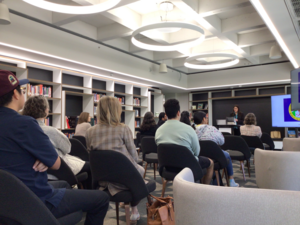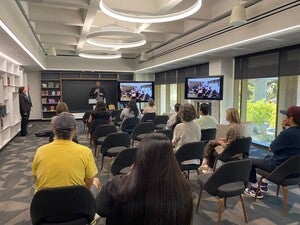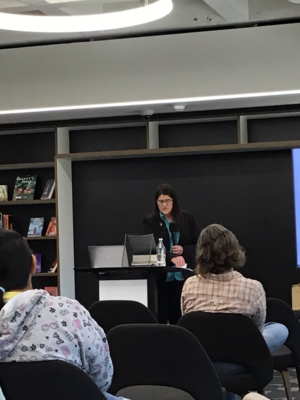Annual Labriola Book Award with Dr. Valerie Lambert
This November, the Labriola Center hosted Dr. Valerie Lambert to speak about her book that won this year's Annual Labriola Book Award.

The Labriola Center's Annual Book Award began in 2008. The Labriola Center book award is national in scope and seeks to promote contemporary work by Indigenous scholars which benefits Indigenous peoples and nations. Books that have been submitted for consideration for the Labriola Center American Indian National Book Award have crossed multiple disciplines or fields of study, but must focus on topics and issues that are pertinent to Indigenous peoples and nations.
This year's Labriola Center's Annual Book Award has been awarded to Dr. Valerie Lambert. Dr. Valerie Lambert is an enrolled citizen of the Choctaw Nation and is a professor of anthropology at the University of North Carolina–Chapel Hill. Her book "Native Agency: Indians in the Bureau of Indian Affairs” won the 2022 Labriola Book award. Valerie is also the author of "Choctaw Nation: A Story of American Indian Resurgence," winner of the 2007 North American Indian Prose Award.

Dr. Jerome Clark (Diné), assistant professor in the New College's School of Humanities, Arts and Cultural Studies, led the Book Award and introduced Dr. Lambert to the stage in the Labriola Center's newly renovated space at Hayden Library. Dr. Lambert spoke about the purpose of her book based on the research she conducted. This book took six years to write, which included a heavy emphasis on research, interviews, and community outreach to tribes and the Bureau of Indian Affairs.
Dr. Lambert reads the opening pages "this book is an effort to make sense of the BIA." She asks herself and the audience, "Why do I need to learn about an agency that has caused so much harm?" This book demonstrates how we research and teach Indigenous studies around sovereignty. She also emphasized storytelling. Dr. Lambert wrote Native Agency in a way that Indigenous communities and non-Native communities can read and understand.
"By the time I could walk, I was introduced to the rage American Indians feel towards the BIA." -Dr. Valerie Lambert

The Bureau of Indian Affairs, first known as the Office of Indian Affairs (OIA), was established in 1824 as an office in the War Department by John Calhoun, Secretary of War. In 1849, OIA was moved into the Department of the Interior and renamed the Bureau of Indian Affairs (BIA) in 1947. The relationship between the BIA and American Indians is a contentious and convoluted one. As noted in Liva Gershon's article, "Native Nations and the BIA: It's Complicated" she mentions the historically harmful relationship: "For more than a century, (the BIA) was part of assaults on Native American people, from the banning of ceremonial dances to the forceable placement of children in boarding schools." Dr. Lambert also notes similar sentiments towards the BIA, that although there is undeniable and irreparable harm that has been perpetuated on American Indian communities across the country, including land allotments, land dispossession, and punishment for speaking our original languages, she wants this book to be a resource and guide for American Indians on how settler colonialism operates in the 21st century and how to access federal power beyond the BIA.
"I want Native communities to see what we are up against and the creative ways we can maneuver around barriers and build the path towards self-governance." As nations within a nation, we will all be better off if we can have more accurate knowledge on how governance works and what it is about. -Dr. Valerie Lambert
You can read Dr. Valerie Lambert's book, "Native Agency: Indians in the Bureau of Indian Affairs" in our open stacks here. Learn more about Dr. Lambert and the Labriola Book Award here.
